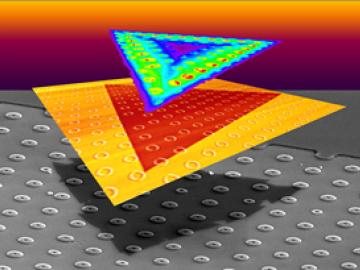
Filter News
Area of Research
- (-) Materials (78)
- (-) Supercomputing (67)
- Advanced Manufacturing (5)
- Biological Systems (1)
- Biology and Environment (34)
- Building Technologies (1)
- Computational Biology (1)
- Computational Engineering (3)
- Computer Science (13)
- Electricity and Smart Grid (1)
- Energy Science (99)
- Fusion and Fission (13)
- Fusion Energy (9)
- Isotope Development and Production (1)
- Isotopes (3)
- Materials Characterization (1)
- Materials for Computing (14)
- Materials Under Extremes (1)
- Mathematics (1)
- National Security (16)
- Neutron Science (31)
- Nuclear Science and Technology (7)
- Quantum information Science (4)
- Sensors and Controls (1)
- Transportation Systems (2)
News Type
News Topics
- (-) Bioenergy (13)
- (-) Biomedical (13)
- (-) Computer Science (48)
- (-) Fusion (5)
- (-) Grid (5)
- (-) Materials Science (56)
- (-) Quantum Science (21)
- (-) Summit (20)
- (-) Transportation (12)
- 3-D Printing/Advanced Manufacturing (21)
- Advanced Reactors (3)
- Artificial Intelligence (15)
- Big Data (5)
- Biology (8)
- Biotechnology (1)
- Buildings (4)
- Chemical Sciences (24)
- Clean Water (1)
- Composites (7)
- Coronavirus (10)
- Critical Materials (15)
- Cybersecurity (6)
- Energy Storage (28)
- Environment (15)
- Exascale Computing (8)
- Frontier (13)
- High-Performance Computing (16)
- Isotopes (7)
- ITER (1)
- Machine Learning (6)
- Materials (53)
- Microscopy (19)
- Molten Salt (3)
- Nanotechnology (31)
- National Security (5)
- Neutron Science (26)
- Nuclear Energy (7)
- Partnerships (8)
- Physics (19)
- Polymers (13)
- Quantum Computing (9)
- Security (4)
- Simulation (2)
- Space Exploration (3)
Media Contacts

A new method developed at Oak Ridge National Laboratory improves the energy efficiency of a desalination process known as solar-thermal evaporation.
A team of scientists led by Oak Ridge National Laboratory have discovered the specific gene that controls an important symbiotic relationship between plants and soil fungi, and successfully facilitated the symbiosis in a plant that

Oak Ridge National Laboratory has teamed with Cornell College and the University of Tennessee to study ways to repurpose waste soft drinks for carbon capture that could help cut carbon dioxide emissions.

A team of researchers at Oak Ridge National Laboratory have demonstrated that designed synthetic polymers can serve as a high-performance binding material for next-generation lithium-ion batteries.

Scientists have discovered a way to alter heat transport in thermoelectric materials, a finding that may ultimately improve energy efficiency as the materials

A team led by scientists at the Department of Energy’s Oak Ridge National Laboratory explored how atomically thin two-dimensional (2D) crystals can grow over 3D objects and how the curvature of those objects can stretch and strain the

OAK RIDGE, Tenn., May 7, 2019—Energy Secretary Rick Perry, Congressman Chuck Fleischmann and lab officials today broke ground on a multipurpose research facility that will provide state-of-the-art laboratory space

OAK RIDGE, Tenn., May 7, 2019—The U.S. Department of Energy today announced a contract with Cray Inc. to build the Frontier supercomputer at Oak Ridge National Laboratory, which is anticipated to debut in 2021 as the world’s most powerful computer with a performance of greater than 1.5 exaflops.

Using Summit, the world’s most powerful supercomputer housed at Oak Ridge National Laboratory, a team led by Argonne National Laboratory ran three of the largest cosmological simulations known to date.

In a step toward advancing small modular nuclear reactor designs, scientists at Oak Ridge National Laboratory have run reactor simulations on ORNL supercomputer Summit with greater-than-expected computational efficiency.


